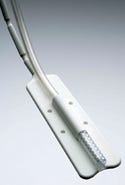Plastics and Elastomers 15406
Laser welding and advances in polycarbonates may benefit medical device development
October 13, 2006
Originally Published MPMN October 2006
PRODUCT UPDATE
Plastics and Elastomers
Laser welding and advances in polycarbonates may benefit medical device development
According to a study by The Freedonia Group Inc., spending for silicone products in the medical market will reach $270 million by 2010. “Silicone medical uses will benefit from heightened applications in areas such as implants, transdermal drug-delivery systems, tubing, and tissue fillers,” the study says. Other materials coming into wider use in the medical device industry include polycarbonate and copolymer blends.
Polycarbonates Find Applications in Medical Components, Packaging
Strength, toughness, rigidity, and resistance to rigorous sterilization conditions, plus its high clarity, are key factors in the increased use of polycarbonate in medical devices.
|
Lexan HPM, a hemocompatible polycarbonate resin supplied by GE Plastics, was used to make an atrial depressor. |
Polycarbonate resins can be injection molded, extruded, blow molded, or thermoformed. Products made with polycarbonate can be sterilized using EtO, gamma radiation, electron-beam radiation, and steam processes. Certain commercial grades of polycarbonates are certified to meet strict biocompatibility standards, such as ISO 10993-1. This is important for OEMs looking to make devices for use in tissue- or blood-contact applications. GE Plastics (Pittsfield, MA) developed its Lexan HPM polycarbonate resin with added hemocompatibility. Surgical tools previously made with stainless steel can be produced using Lexan HPM, such as an atrial depressor used in heart surgery.
|
The top housing and chassis of an insulin management system were made from polycarbonate compounds provided by RTP Co. |
When blended with other resins, such as ABS and polyester, polycarbonates can be used in medical instrument housings. The polyester adds chemical resistance to the housings, while high-flow properties come from the use of ABS. RTP Co. (Winona, MN) offers polycarbonate compounds for use in medical device housings and enclosures. Its 300-series compound incorporates light-diffusing technology to make semiopaque parts.
To further expand medical markets for polycarbonates, resin suppliers are bringing out new grades with enhanced properties, such as greater heat and radiation resistance, higher flow, the ability to self-release from molds, and greater resistance to lipids. Standard grades of polycarbonate for medical devices can be steam-autoclaved at temperatures up to 121°C. However, faster steam-autoclaving processes require materials to withstand even higher temperatures. To meet this demand, suppliers have introduced polycarbonate grades that can be autoclaved at temperatures as high as 134°C. While multiple autoclaving of polycarbonate devices is not generally recommended, some manufacturers now offer polycarbonate grades that are able to be autoclaved more than once.
Polycarbonates do not become brittle when exposed to gamma rays and electron beams used in radiation sterilization. However, polycarbonates do tend to yellow upon exposure to radiation. To prevent discoloration, suppliers have included additives that absorb the radiation. The Zelux GS polycarbonate resin from Westlake Plastics Co. (Lenni, PA) incorporates the company’s color enhancement technology to reduce yellowing caused by gamma radiation. Another approach has been to market grades of polycarbonate that are inherently radiation stable and therefore do not require additives.
High-flow polycarbonate products have recently been unveiled for the medical market, with the aim of increasing the output by converters. Standard polycarbonate grades for medical molding have a melt-flow rate (MFR) in the 5–15 g/10-min range. The new grades have a MFR of 20–37 g/10 min. While high melt flow has traditionally been achieved with the use of additives, some of the newer polycarbonates exhibit enhanced flow without additives, relying instead on proprietary copolymer formulations.
Easy mold-release polycarbonate grades are also available. These products contain internal mold-release agents that make it unnecessary to spray release agents into the mold. Such agents can contaminate the molded part and must be regularly cleaned away, which extends production cycles and adds to costs. Lexan HPX, a copolymer polycarbonate, was developed by GE Plastics for use in applications that require increased melt flow and easy mold release.
More and more, intravenous solutions contain lipid-based emulsions of drugs. Lipids attack polycarbonates, causing stress cracking. To address this issue, suppliers have introduced lipid-resistant polycarbonate grades. The Makrolon family of polycarbonate resins from Bayer MaterialScience LLC (Pittsburgh) are formulated to provide increased resistance to chemical attack from intravenous fluid products. Y-sites with integrated check valves and luer connectors have been developed using Makrolon Rx1805.
Polycarbonates are also used in dialysis filter membranes, surgical instrument handles, and the housings of blood oxygenators. Manifolds and stopcocks of IV connectors, needle-free injection systems, perfusion equipment, and blood reservoirs are frequently made of polycarbonate. Endoscopy tools, such as trocars and retractors, and products used in minimally invasive surgery may benefit from the strength and chemical inertness of polycarbonate. Medical device packaging is often fabricated from thermoformed polycarbonate films. These films allow for sterilization of the packaged device via radiation.
Emerging applications of polycarbonates include inhalers, orthopedic devices, and lab-on-a-chip devices for determining blood chemistry or analyzing proteins.
Sterility Stays Intact with Laser Welding
Once cost-prohibitive, laser welding of plastics is becoming more common as equipment prices drop. Laser welding joins thermoplastic sheets, films, or molded parts using the heating power of laser beams to melt plastic at the interfaces. In medical manufacturing, laser welding is often used when the parts being joined require sterile conditions.
The most common form of laser welding is called transmission laser welding. In this process, two plastic parts are clamped together. A laser beam, in the short-wavelength infrared region, is directed at the section to be joined. The beam passes through the transparent top layer and is absorbed by the bottom layer. Absorption of the laser energy causes the bottom layer to heat up, melting both upper and lower layers of plastic and causing them to fuse. The upper layer can be clear or colored, but must be sufficiently light transmissible to allow the laser beam to pass through to the lower layer.
Laser welding has several benefits. The equipment can be manipulated robotically in order to weld complex parts. Furthermore, the tool does not contact the parts being joined, thus ensuring sterility of the assembly. The vibration-free technique produces strong, high-precision joints and welds without flash. Thermal damage and distortion are minimal. Gas-tight or hermetic seals can be formed using laser welding. Resins of different compositions and colors can be joined.
|
A mask welding process provided by Leister Technologies creates fine, precise weld lines or complex structures and contours. |
Leister Technologies LLC (Itasca, IL) offers a patented mask welding process that allows for very precise and fine weld lines. The technique uses a collimated laser or curtain of light and incorporates a mask to block the transmission of the laser beam as it is scanned over a part. The laser beam is only exposed to the surface area not obscured by the mask. Therefore, the mask shape determines the pattern of weld produced. “The mask weld process produces weld lines as narrow as 100 µm,” says Bill Miller, sales manager. “The process can also produce welds with elaborate structures or contours.” During one weld sequence, it is possible to weld lines with different widths and shapes, as well as whole areas of weld.
Laser welding can be used in the assembly of fluid reservoirs and filters, tube-to-tube connectors, ostomy bags, hearing aids, implants, and microfluidic devices used in analysis.
Copyright ©2006 Medical Product Manufacturing News
You May Also Like



.png?width=300&auto=webp&quality=80&disable=upscale)

